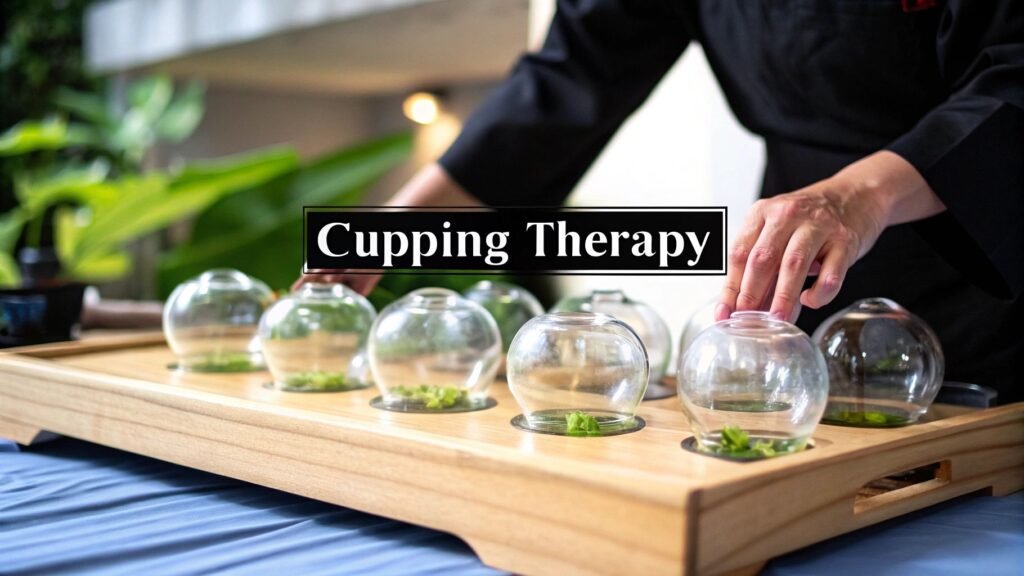Cupping therapy is an ancient practice that uses special cups placed on the skin to create a vacuum. The easiest way to think about it is as a reverse massage. Instead of applying pressure down into the muscles, the suction gently pulls the skin, muscle, and fascia upward, helping to release tension and promote healing.
Unpacking the Ancient Art of Cupping
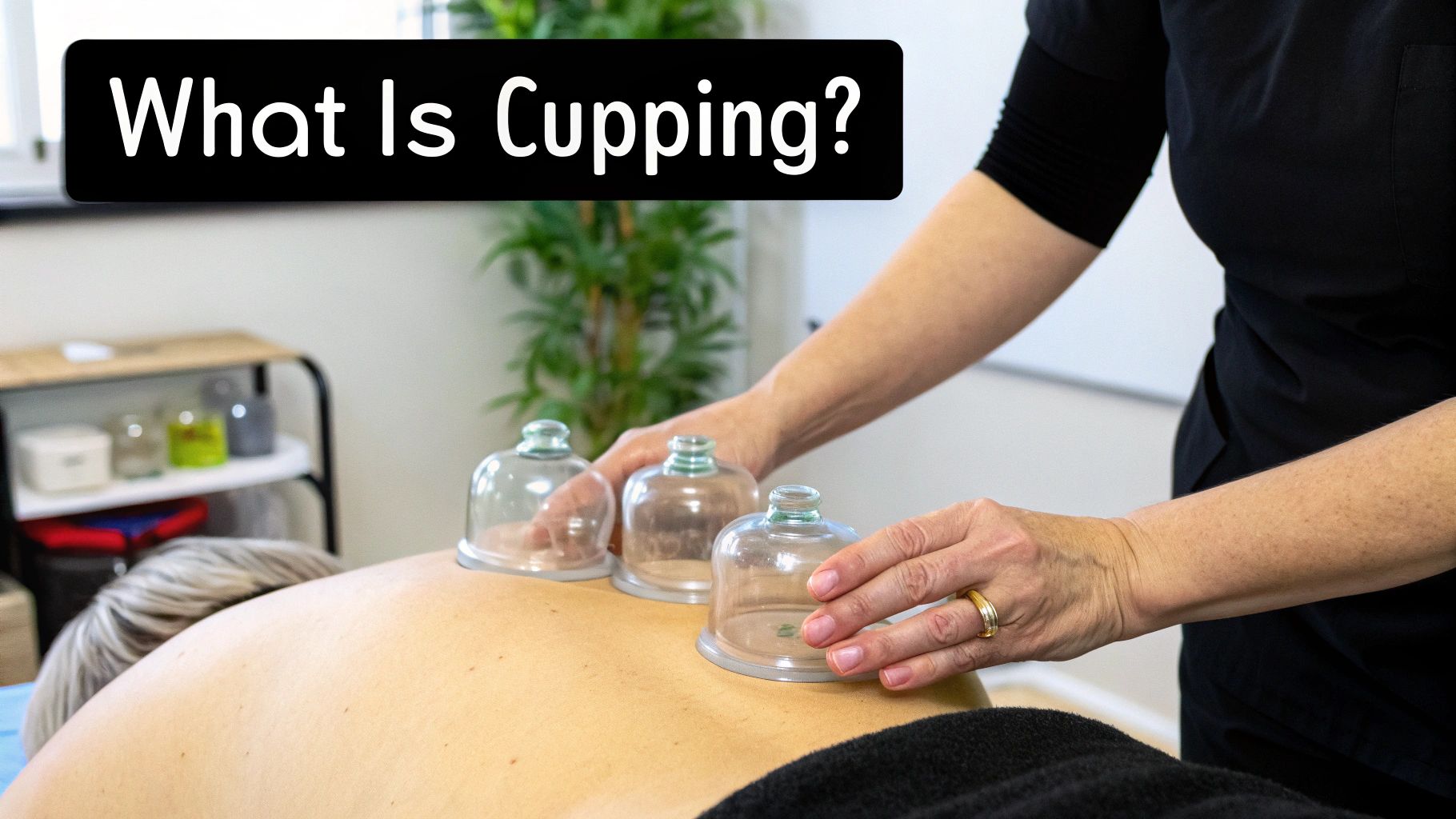
You’ve probably seen those signature circular marks on athletes like Michael Phelps or celebrities, but this is far from a new wellness trend. Cupping has deep roots stretching back thousands of years, with evidence of its use in ancient Egyptian, Middle Eastern, and Chinese cultures for everything from pain and inflammation to general well-being.
At its heart, the therapy is all about restoring balance and improving flow within the body. Practitioners believe the suction created by the cups stimulates blood circulation, breaks up adhesions in the connective tissue (fascia), and kickstarts the body's own natural healing abilities. It's a foundational technique in many traditional systems, and you can learn more about its place in Traditional Chinese Medicine by exploring our detailed guide here: https://drerictsai.com/f/%F0%9F%A7%8D%E2%80%8D%E2%99%82%EF%B8%8Feric-tsai-lac-msaom-bpharm#44cae461-999c-4ec1-82f4-fe3dbdc25492/what-is-traditional-chinese-medicine.
To get a quick sense of the key ideas behind this therapy, the table below breaks down the core concepts.
Cupping Therapy at a Glance
| Concept | Brief Explanation |
|---|---|
| Mechanism | Creates negative pressure (suction) to lift and decompress underlying tissue. |
| Primary Goal | To improve circulation, release muscle tension, and reduce pain. |
| Core Principle | Restores the flow of blood and energy (Qi) to promote natural healing. |
| Common Use Cases | Pain relief, muscle recovery, inflammation reduction, and relaxation. |
This snapshot shows how cupping fits into a broader picture of health and wellness by addressing the body's internal environment.
From Ancient Practice to Modern Wellness
Today, cupping is making a serious comeback. It's often used as a complementary therapy, fitting perfectly within a holistic wellness approach that recognizes the deep connection between mind and body. You'll now find it used regularly in modern physical therapy clinics and sports medicine facilities, a testament to its value in muscle recovery and pain management.
This rise in popularity is also showing up in market trends. The global market for cupping equipment is projected to hit $67.89 million by 2025, and it's expected to keep growing steadily through 2033. This growth is largely driven by a renewed interest in effective, traditional therapies.
Cupping therapy is not about the marks it leaves behind; it's about the relief and restored function it can bring to the body by decompressing tissues and enhancing circulation.
Ultimately, understanding cupping means looking past the temporary marks on the skin. It’s a technique designed to work on the body's deeper tissues, clearing out stagnation and creating a healthier internal environment. By gently lifting and separating layers of fascia and muscle, it delivers a unique therapeutic effect aimed at bringing back mobility and easing discomfort.
Understanding the Science Behind the Suction
So, how does putting a cup on your skin actually relieve pain? It all comes down to the unique power of negative pressure. While a typical massage pushes down and compresses your muscles and tissues, cupping does the exact opposite. It creates a vacuum that gently lifts the skin, fascia, and muscle layers upward.
Think of it like a knotted-up garden hose that’s blocking the water flow. The suction from the cup acts as a way to "unkink" that hose. This lifting action creates space between the layers of soft tissue, providing an immediate release for those tight knots and sticky adhesions that cause so much pain and stiffness.
This decompression sets off a chain reaction in the body. As the tissues are gently separated, it triggers a rush of localized blood flow. This fresh, oxygenated blood floods the area, bringing with it all the nutrients needed for repair. At the same time, it helps flush out metabolic waste products, like lactic acid, that build up and cause soreness.
Decompressing Tissue to Restore Flow
But the benefits go much deeper than just improved blood flow. The suction has a direct effect on the fascial network—that intricate web of connective tissue wrapping around every single muscle and organ. Fascia can get tight and restricted from injuries, repetitive movements, or even just sitting too long, leading to chronic pain and limited mobility.
Cupping therapy works by creating a controlled micro-trauma. This sends a signal to the body to kickstart its natural healing process, which helps reduce inflammation, break down scar tissue, and restore healthy function to the area.
This targeted release of fascial tension is a big reason why so many athletes and people with chronic pain swear by it. It helps bring back the natural elasticity and glide between tissue layers, which in turn improves your range of motion.
Stimulating Natural Healing Responses
Beyond that, the therapy gives a powerful boost to your lymphatic system, which is basically your body’s internal drainage and cleanup crew. Better lymphatic flow means cellular debris and excess fluid get cleared out more efficiently, which reduces swelling and speeds up the healing process. When you ask what is cupping therapy, understanding these interconnected systems is key. For a more detailed look at the physiological mechanisms, you can read more about how cupping therapy works here.
Here are the key physiological effects in a nutshell:
- Increased Vasodilation: The suction causes blood vessels to expand, dramatically improving circulation to the target area.
- Fascial Decompression: It releases stuck-down adhesions and tension in your connective tissue.
- Enhanced Lymphatic Drainage: The therapy helps your body remove toxins and reduce inflammation more effectively.
- Pain Modulation: The sensation can stimulate sensory nerves, helping to override and reduce pain signals sent to the brain.
Ultimately, the science behind the suction is all about creating the perfect environment for your body to heal itself. By decompressing tissue, boosting circulation, and clearing out metabolic junk, cupping gives your body a direct mechanical and physiological nudge toward recovery and relief.
Exploring Different Cupping Methods
When people talk about cupping, they're often picturing just one type of therapy. But the reality is much more nuanced. Just like a personal trainer might choose different exercises for different goals, a cupping practitioner has several distinct methods in their toolkit.
Knowing the difference between these approaches is the first step in figuring out which one might be right for you. Let's break down the most common techniques you'll encounter.
Dry Cupping For General Wellness
The most familiar and widely practiced method is dry cupping. This is the non-invasive technique you've likely seen on athletes and celebrities, where suction is applied to the skin to gently lift the underlying tissue. The skin is never broken, making it a great starting point for most people.
Within dry cupping, there are two primary applications. The first is static cupping, where cups are placed on a specific trigger point—think a stubborn knot in your shoulder—and left in place for several minutes. The sustained suction provides a deep, focused release.
The second is massage cupping, sometimes called gliding cupping. Here, the practitioner applies oil to your skin first, which allows them to slide the suctioned cups over a larger area, like your entire back. This feels like a reverse deep-tissue massage, pulling tension up and away from the muscle, and it's fantastic for releasing widespread fascial tightness.
Think of it this way: static cupping is like using your thumb to hold pressure on a single, deep knot. Massage cupping is like a long, sweeping massage stroke that covers the whole muscle.
Wet Cupping A More Intensive Approach
A more specialized and traditional method is wet cupping, also known in many cultures as Hijama. This technique is more intensive because it involves an extra step: after the initial cupping, the practitioner removes the cup and makes a few tiny, superficial scratches on the skin.
The cup is then reapplied, and the suction draws out a small amount of stagnant blood and interstitial fluid. While it might sound a bit intense, it's performed by highly trained professionals in a sterile environment. It's often reserved for more persistent conditions where the goal is a deeper level of detoxification and cleansing.
To make the distinction clearer, let's compare the two main methods side-by-side.
Comparison of Common Cupping Methods
This table breaks down the core differences between the non-invasive approach of dry cupping and the more intensive Hijama technique.
| Feature | Dry Cupping | Wet Cupping (Hijama) |
|---|---|---|
| Invasiveness | Non-invasive; the skin is not broken. | Invasive; involves superficial skin incisions. |
| Primary Goal | Relieve muscle tension, improve circulation, reduce pain. | Detoxification, remove stagnant blood, address chronic conditions. |
| Procedure | Cups are placed on the skin and create suction. | Initial cupping, followed by tiny incisions and a second round of suction. |
| Best For | General pain, muscle soreness, stress relief, first-timers. | Stubborn pain, inflammation, and specific internal conditions. |
| Practitioner | Performed by massage therapists, acupuncturists, and physical therapists. | Requires a specialized, certified practitioner with sterile protocols. |
Understanding these key differences helps you and your practitioner decide on the most appropriate and effective treatment for your specific needs.
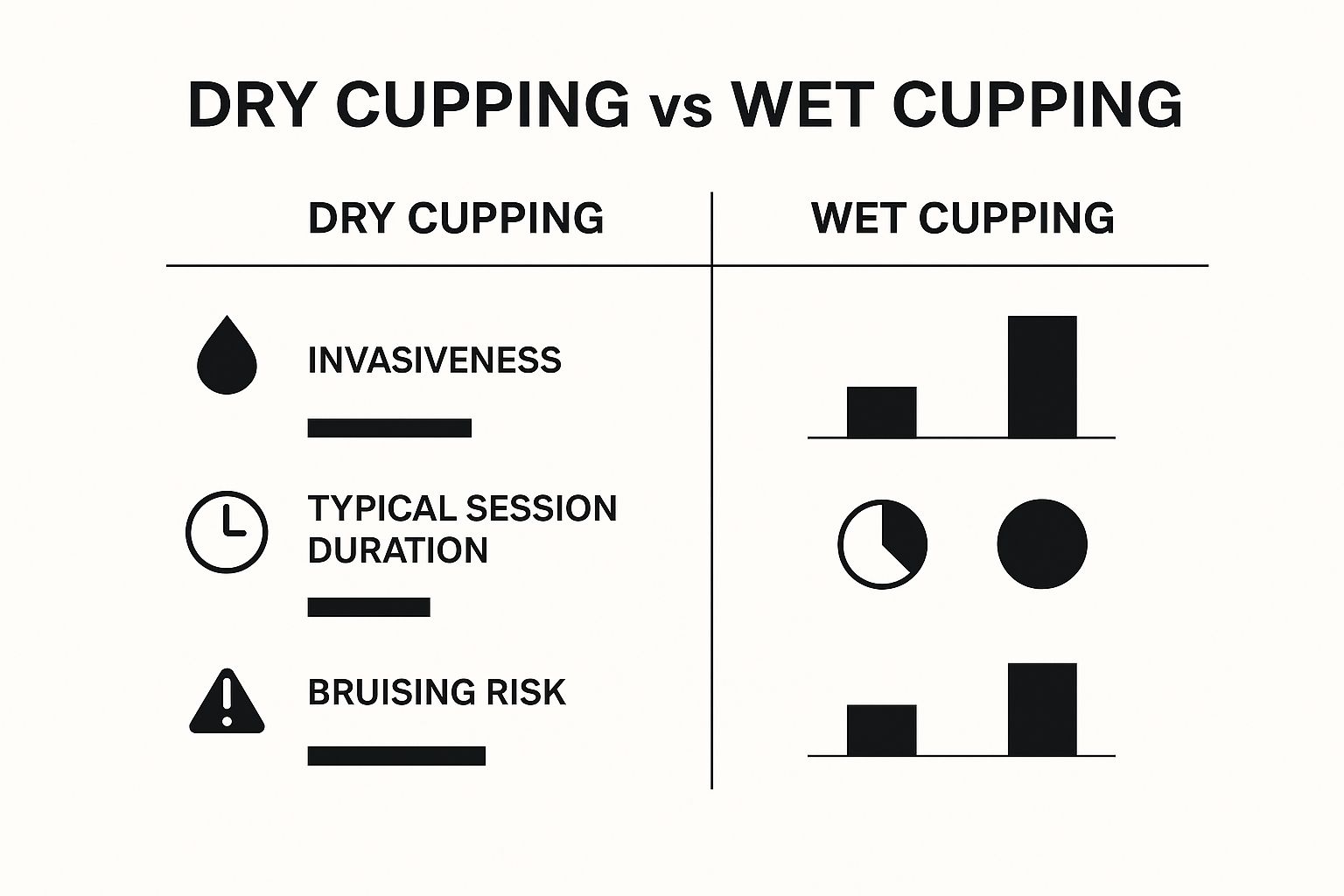
Beyond the method, the tools themselves can vary, from traditional glass and bamboo cups to modern silicone ones. The most common type today is vacuum cupping, where a pump creates suction. This simple and affordable approach held a 43% market share in 2023.
Interestingly, this ancient therapy is gaining serious traction in modern medicine. Hospitals are now the biggest users of cupping, accounting for over 54% of the market, which shows just how integrated it's becoming in mainstream patient care. You can dive deeper into the cupping therapy market trends and statistics to see how the practice is growing.
What Science Says About the Benefits of Cupping
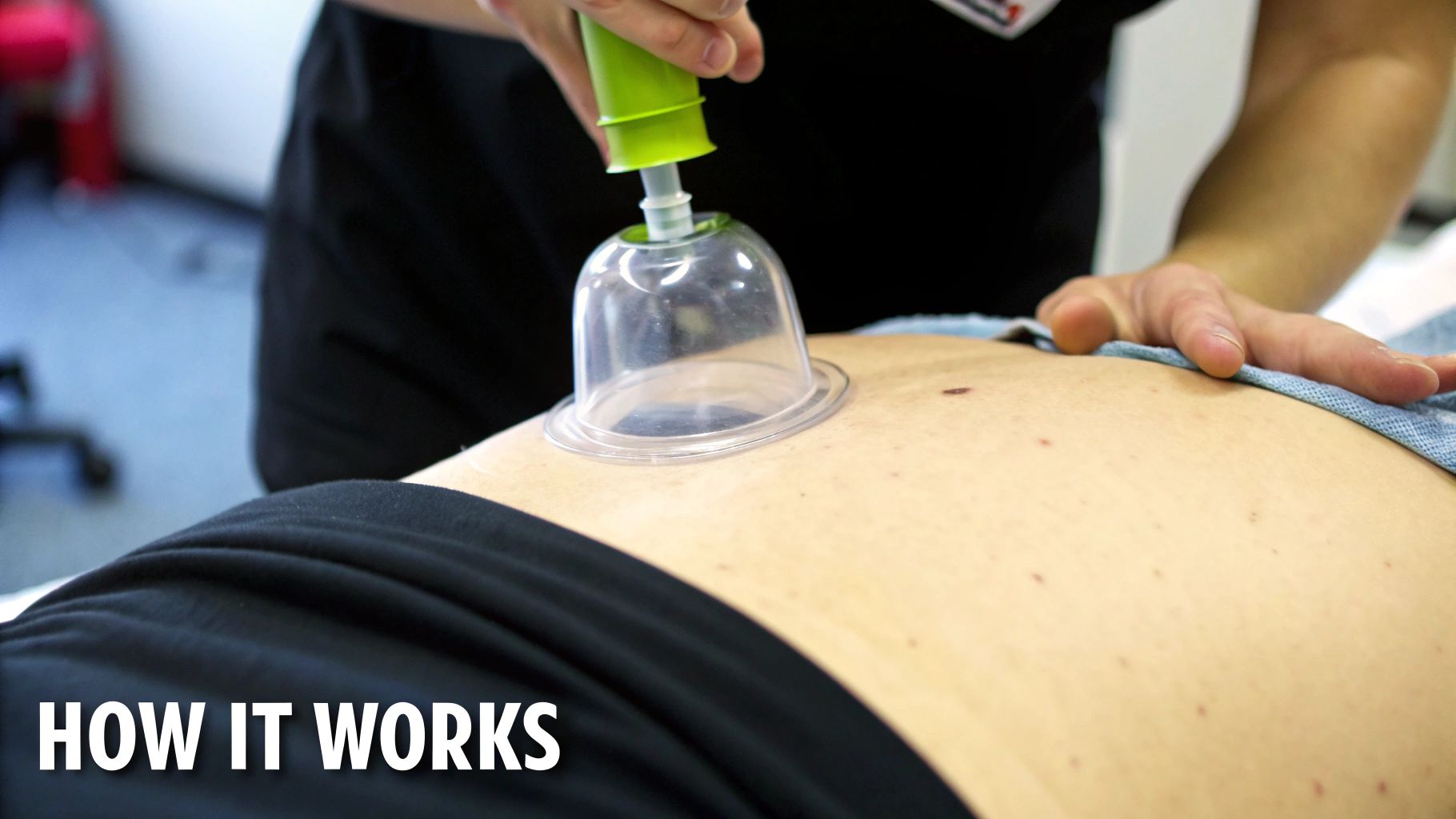
From elite athletes chasing their next personal best to office workers struggling with that all-too-familiar neck stiffness, people are finding real relief with cupping. Though its roots are ancient, modern science is finally starting to catch up, providing evidence for what practitioners have known for centuries. At its heart, cupping is a powerful tool for managing pain.
By lifting and decompressing tissue, the cups kickstart local circulation and directly address the physiological roots of discomfort. This makes it an incredibly effective approach for tough-to-treat conditions like chronic lower back pain, fibromyalgia, and those stubborn knots in your shoulders that never seem to go away. The therapy gets to work by easing muscle tension, boosting blood flow, and calming inflammation right where you need it most.
More Than Just Muscle Aches
While cupping is a go-to for general soreness, its benefits go much deeper, tackling specific types of pain that can seriously disrupt your life. For example, many people suffering from migraines and tension headaches find that cupping provides significant relief.
By releasing the tight, bunched-up muscles in the neck and upper back, cupping can deactivate the very trigger points that fuel headache frequency and intensity. The research is pretty compelling. Some clinical studies have shown that cupping can reduce headache severity by a staggering 66%. In those same studies, participants reported having headaches 12.6 fewer days per month, a life-changing improvement for anyone who suffers from them. You can dive deeper into the research and explore cupping therapy for pain and other conditions here.
The magic of cupping really comes down to its ability to break up localized stagnation. It pulls congested blood and metabolic byproducts out of deep tissues, making room for fresh, oxygen-rich blood to rush in and jumpstart the body's own healing mechanisms.
Speeding Up Recovery and Improving Overall Wellness
Cupping isn't just about putting out fires; it's also about building a more resilient body. Athletes have long sworn by it as their secret weapon for a faster comeback, but the benefits are for everyone, not just pros.
Here’s a look at what else cupping can do:
- Faster Athletic Recovery: It helps flush out lactic acid and other metabolic waste, calming inflammation and allowing muscles to repair more efficiently after a tough workout. Less soreness means less downtime.
- Better Respiratory Function: When placed strategically on the back, cups can help loosen stubborn phlegm and open up the airways, offering comfort from issues like the common cold, bronchitis, or asthma.
- Greater Mobility and Flexibility: Cupping is fantastic for releasing adhesions in the fascia—the web of connective tissue that encases our muscles. This can restore a full range of motion to stiff joints and tight muscle groups.
While the distinctive circular marks are what most people notice, the real work is happening beneath the skin. It’s a targeted therapy designed to hit the reset button on dysfunctional tissue, soothe the nervous system, and empower the body to do what it does best: heal itself. Even as more research emerges, the existing evidence and countless success stories show it’s a safe and valuable part of any modern wellness strategy.
Your First Cupping Session From Start to Finish
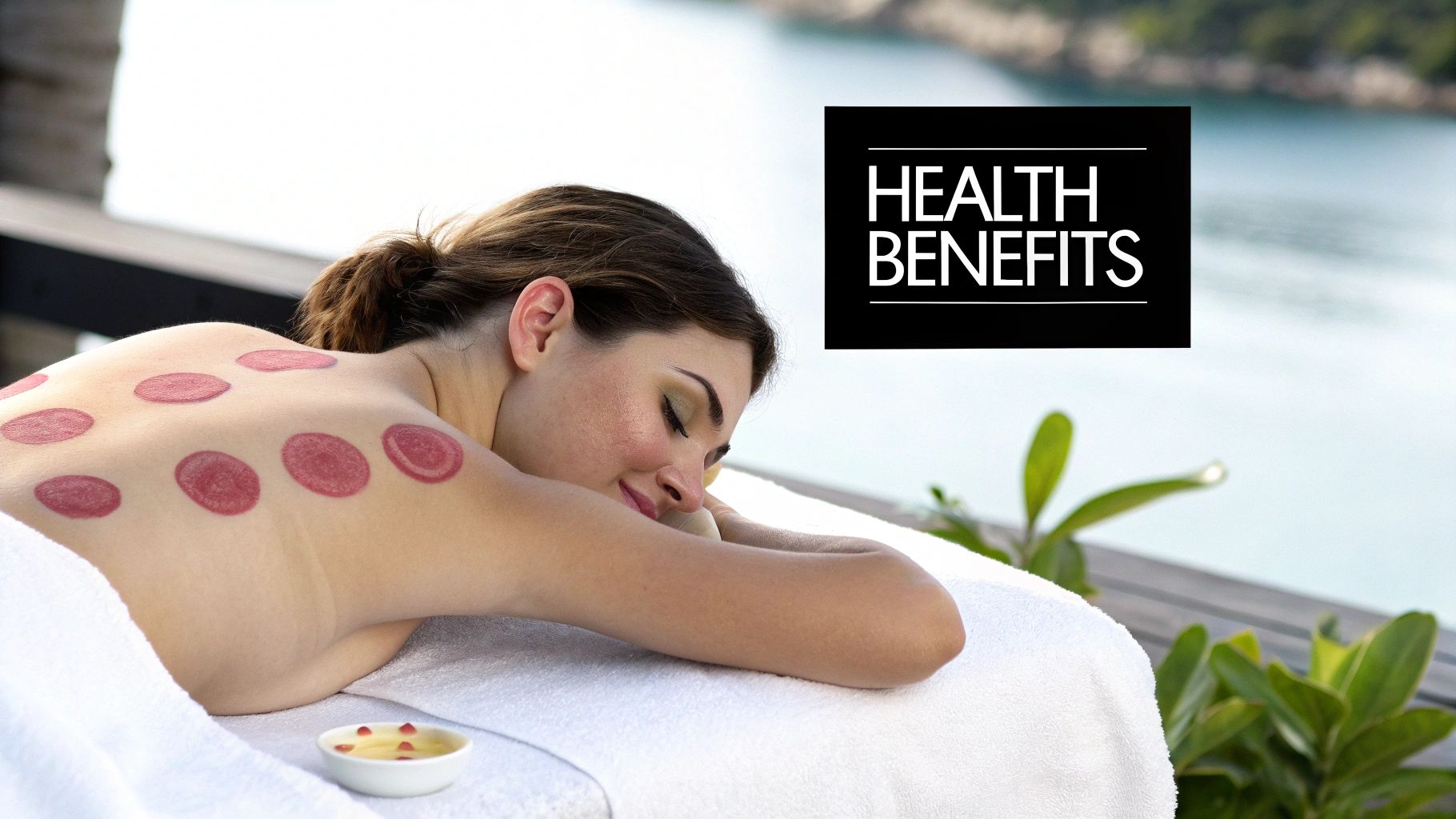
Walking into your first cupping session might feel a bit mysterious, but the process is actually quite simple and relaxing once you know what's happening. It all starts with a quick chat. Your practitioner will take a few minutes to go over your health history, ask about any specific aches or pains you're feeling, and understand what you're hoping to get out of the treatment.
From there, you'll get comfortable on a treatment table. Your practitioner will select the right spots—usually your back, shoulders, or legs—and apply the cups. You'll immediately feel a tight, pulling sensation as the suction gently lifts your skin and the underlying muscle. It's a unique feeling, but it shouldn't be painful. If the pressure feels too intense, just let them know; it's easily adjustable.
The Cupping Process and What to Expect
Once the cups are set, they’ll stay in place for anywhere from 5 to 15 minutes. Your job is just to lie still and relax. This quiet time allows the therapy to do its work, releasing tight fascia, easing muscle tension, and drawing blood flow to the area. It’s all about giving your body a chance to kickstart its own healing.
When the time is up, the practitioner will break the seal on each cup to release the suction. This part is quick and painless. Many people feel an immediate sense of relief or lightness in the treated areas, like a stubborn knot has finally started to let go.
Understanding the Famous Cupping Marks
Let's talk about those circular marks, the most recognizable sign of cupping. It’s really important to know that these are not bruises. A bruise is caused by trauma that breaks blood vessels. The marks from what is cupping therapy, on the other hand, are from stagnant fluid, old blood, and metabolic waste being pulled from deep within the tissue up to the surface.
For a trained practitioner, the color of the marks tells a story. Lighter pink can indicate healthy circulation, while a deep purple suggests long-standing stagnation or an old injury that’s been holding on.
These marks are completely temporary and usually disappear on their own within three to ten days as your body’s lymphatic system clears everything away.
To get the most out of your session, a little bit of aftercare goes a long way:
- Stay Hydrated: Drink plenty of water. This helps your body flush out the toxins that were pulled to the surface during the treatment.
- Keep the Area Warm: For the next 24 hours, try to keep the cupped areas covered and away from cold air or drafts.
- Rest: It’s best to avoid any intense workouts or deep tissue massages for the rest of the day. Give your body some time to recover and integrate the work that was done.
How to Find a Qualified Cupping Practitioner
While cupping is generally very safe, its success—and your safety—really boils down to the skill of the person performing it. A truly experienced therapist knows exactly how to apply the technique to minimize any risks and get you the best possible results. Choosing the right professional isn't just a small detail; it's the most critical step you'll take to protect your health.
When cupping is done incorrectly, it can lead to more than just a lack of results. Mild side effects like the well-known circular marks and a bit of lightheadedness are normal. However, an unskilled application can cause nasty blisters, burns, or even skin infections.
This is why you absolutely have to vet your potential providers. A true professional will always start with a thorough health intake to make sure you don't have any contraindications—any conditions that would make cupping a bad idea for you.
Vetting Credentials and Asking the Right Questions
When you start your search, the first thing to look for are specific, verifiable credentials. Think of this as your first line of defense, ensuring the person you trust has formal training and a solid grasp of anatomy, physiology, and safety protocols.
Here’s what to look for:
- Licensed Acupuncturist (L.Ac.): In my field, acupuncturists receive comprehensive training in cupping as a core part of their Traditional Chinese Medicine education.
- Certified Cupping Therapist (CCT): This is a great sign, as it shows the practitioner has pursued specialized training specifically in cupping techniques.
- Other Licensed Professionals: You'll find that some physical therapists, chiropractors, and massage therapists also offer cupping. That's fine, but don't be afraid to ask about the specifics of their cupping education and where they were trained.
Once you’ve found someone who looks promising, set up a consultation. Go in with a list of questions ready—this is your chance to get a feel for their expertise and how they approach their practice.
A great practitioner will welcome your questions and provide clear, confident answers. They should be able to walk you through their sterilization procedures, explain what you can expect during and after a session, and describe how they'll customize the treatment just for you.
Don't hesitate to ask about their experience treating conditions like yours. A good fit is someone who understands your specific goals and has a track record of helping people with similar issues.
For those in California searching for a trusted professional, you can explore options for acupuncture and herbs near you to find a qualified practitioner. Taking that extra time to find the right expert is what ensures your cupping therapy experience is not only effective but also completely safe.
Answering Your Questions About Cupping
It's completely normal to have questions before trying a new therapy, and cupping is no exception. Getting a clear picture of what to expect can make all the difference, helping you relax and get the most out of your session. Let's walk through some of the most common questions we hear.
Is Cupping Painful?
This is usually the very first thing people ask. The short answer is no, it shouldn't be painful. What you'll feel is a tight, pulling sensation on your skin as the suction is created.
Most people find the feeling unique but not at all unpleasant. A good practitioner will always check in with you and can adjust the level of suction to your personal comfort level, making sure the experience is a therapeutic one.
How Long Will the Marks Last?
Ah, the famous "cupping marks." It's important to know these aren't bruises. A bruise is caused by trauma that breaks blood vessels. Cupping marks, on the other hand, are the result of pulling stagnant fluid and metabolic waste from deep within the muscle tissue up to the skin's surface.
Think of the color of the marks as a roadmap for your therapist. Darker circles often point to an area with significant stagnation or an old injury, while lighter marks suggest healthier circulation.
These marks are temporary and will usually fade completely within 3 to 10 days. Many people notice that after a few sessions, the marks become lighter and disappear faster—a great sign that circulation is improving!
How Often Should I Get Cupping?
There's no single answer to this, as the right frequency depends entirely on you, your body, and your health goals. Your therapist will work with you to create a plan that makes sense for your specific situation.
However, here are a few common scenarios:
- For an Acute Injury: If you're dealing with a recent sprain or a sudden flare-up, your therapist might suggest one or two sessions per week to get things under control.
- For a Chronic Issue: For more persistent problems like long-term back pain, sessions are often spaced out to every week or two.
- For General Wellness: If you're using cupping for maintenance and prevention, coming in once or twice a month is usually perfect for keeping things in balance.
The key is to create a sustainable schedule that helps you achieve and maintain your wellness goals.
At Eric Tsai Acupuncture and Herbs, we're passionate about creating personalized treatment plans that draw on the wisdom of Traditional Chinese Medicine. If you're curious about how cupping can fit into your health journey, we invite you to book a consultation with us today.

